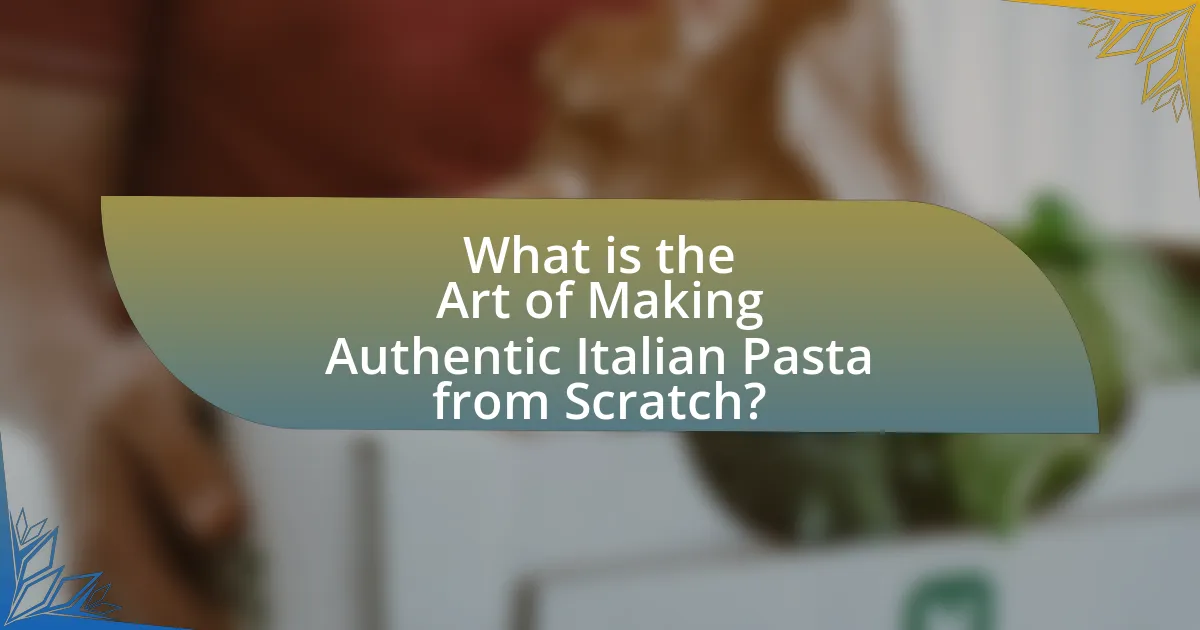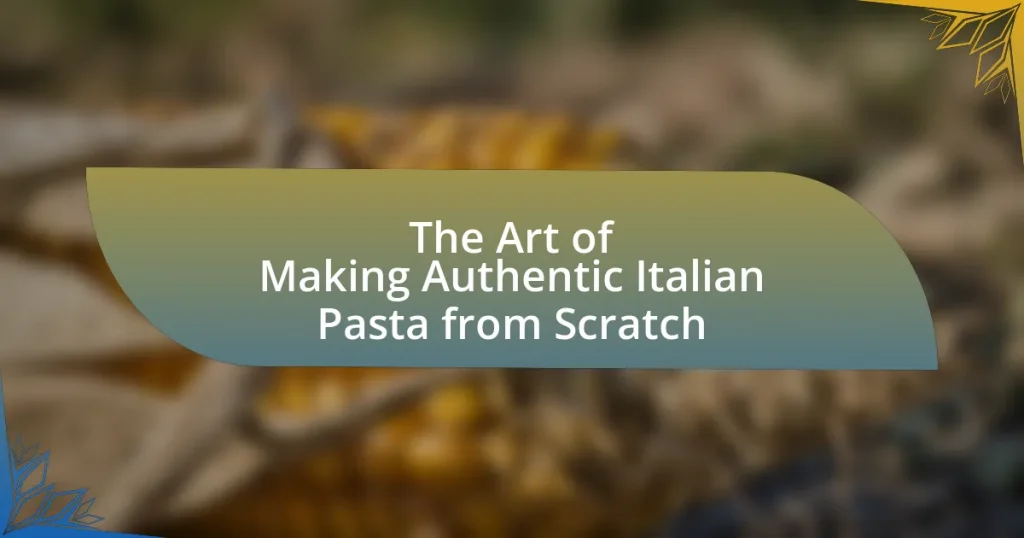The article focuses on the art of making authentic Italian pasta from scratch, emphasizing the importance of high-quality ingredients, traditional techniques, and regional variations. It outlines the essential components for pasta-making, including durum wheat semolina and water, and details the historical context and cultural significance of pasta in Italy. Key topics include the definition of authentic pasta, traditional methods, essential tools, cooking techniques, and common challenges faced during the process. Additionally, the article explores regional differences in pasta recipes and offers best practices for storing and preserving homemade pasta.

What is the Art of Making Authentic Italian Pasta from Scratch?
The art of making authentic Italian pasta from scratch involves a precise combination of high-quality ingredients, traditional techniques, and careful attention to detail. Authentic pasta is typically made using just two ingredients: durum wheat semolina and water, which create a firm texture ideal for holding sauces. The dough is kneaded until smooth, rested to allow gluten development, and then rolled out or shaped into various forms such as tagliatelle, ravioli, or gnocchi.
Historically, Italian pasta-making dates back to ancient times, with references found in texts from the 1st century AD. The process emphasizes the importance of using local ingredients and methods passed down through generations, ensuring that each region of Italy has its unique pasta shapes and recipes. This dedication to tradition and quality is what defines authentic Italian pasta-making.
How is authentic Italian pasta defined?
Authentic Italian pasta is defined by its use of high-quality durum wheat semolina and water, resulting in a firm texture and ability to hold sauces. This definition is rooted in traditional Italian culinary practices, where pasta is often made fresh and shaped by hand or through specific machinery. The Italian government has established regulations for pasta production, including the designation of “Pasta di Gragnano,” which signifies pasta made in Gragnano, a town known for its artisanal pasta-making techniques. These standards ensure that authentic Italian pasta maintains its cultural and gastronomic integrity.
What ingredients are essential for making authentic Italian pasta?
The essential ingredients for making authentic Italian pasta are durum wheat semolina and water. Durum wheat semolina is a high-protein flour that provides the necessary gluten structure for pasta, ensuring it holds its shape during cooking. Water is mixed with the semolina to form a dough, which is then kneaded and shaped into various pasta forms. This combination has been used for centuries in Italy, reflecting traditional methods that emphasize quality and simplicity in pasta-making.
Why is the quality of ingredients important in pasta making?
The quality of ingredients is crucial in pasta making because it directly affects the texture, flavor, and overall authenticity of the final product. High-quality flour, such as semolina or 00 flour, provides the right gluten structure, resulting in a firm yet tender pasta that holds sauce well. Fresh eggs enhance richness and color, contributing to a more flavorful and appealing dish. Studies show that using premium ingredients can elevate the sensory experience, as demonstrated by taste tests where pasta made with high-quality ingredients consistently scores higher in flavor and texture assessments.
What are the traditional methods of making pasta?
Traditional methods of making pasta include using simple ingredients such as flour and water, often with the addition of eggs for richer varieties. The process typically involves mixing the flour and water or eggs to form a dough, kneading it until smooth, and then rolling it out to the desired thickness. This dough can be cut into various shapes, such as tagliatelle or lasagna sheets. Historically, this technique has been passed down through generations in Italy, with regional variations influencing the specific types of flour used and the shapes created. For example, in Emilia-Romagna, a common practice is to use a mix of durum wheat semolina and all-purpose flour, which contributes to the pasta’s texture and flavor.
How do different regions in Italy influence pasta-making techniques?
Different regions in Italy significantly influence pasta-making techniques through variations in ingredients, shapes, and cooking methods. For instance, in the northern regions like Emilia-Romagna, fresh egg pasta is prevalent, leading to dishes such as tagliatelle and lasagna, while in southern regions like Campania, durum wheat is favored, resulting in dried pasta shapes like spaghetti and penne. Additionally, regional sauces and local produce dictate the types of pasta served; for example, pesto is a staple in Liguria, complementing the region’s trofie pasta. Historical practices and local traditions further shape these techniques, ensuring that each region’s pasta reflects its unique cultural identity.
What tools are commonly used in the process of making pasta?
Common tools used in the process of making pasta include a mixing bowl, rolling pin, pasta machine, and knife or pasta cutter. The mixing bowl is essential for combining flour and eggs, while the rolling pin helps to flatten the dough to the desired thickness. A pasta machine can further refine the dough and create uniform sheets, and a knife or pasta cutter is used to shape the pasta into various forms. These tools are fundamental in traditional pasta-making, ensuring consistency and quality in the final product.
What are the key steps in making pasta from scratch?
The key steps in making pasta from scratch include measuring and mixing flour and eggs, kneading the dough, resting the dough, rolling it out, and cutting it into desired shapes. First, combine flour and eggs in a bowl, typically using a ratio of about 100 grams of flour per egg. Knead the mixture until it becomes smooth and elastic, which usually takes about 10 minutes. After kneading, let the dough rest for at least 30 minutes to allow the gluten to relax, making it easier to roll out. Next, roll the dough out using a pasta machine or a rolling pin to your desired thickness. Finally, cut the rolled dough into shapes such as fettuccine or lasagna sheets. These steps are essential for creating authentic pasta, as they ensure the right texture and flavor.
How do you prepare the dough for pasta?
To prepare the dough for pasta, combine flour and eggs in a bowl, mixing until a cohesive dough forms. Typically, a ratio of 100 grams of flour to one large egg is used, with all-purpose or semolina flour being common choices. Knead the dough on a floured surface for about 10 minutes until it becomes smooth and elastic. This kneading process develops gluten, which is essential for the pasta’s structure. After kneading, wrap the dough in plastic wrap and let it rest for at least 30 minutes to allow the gluten to relax, making it easier to roll out. This method is supported by traditional Italian cooking practices, emphasizing the importance of quality ingredients and technique in creating authentic pasta.
What techniques are used to shape different types of pasta?
Various techniques are employed to shape different types of pasta, including rolling, cutting, and molding. For instance, rolling dough into thin sheets is essential for making lasagna and ravioli, while cutting the sheets into strips creates fettuccine or tagliatelle. Molding techniques, such as using a pasta machine or hand-rolling, are crucial for shaping stuffed pasta like tortellini. Additionally, extruding dough through specialized dies allows for the creation of tubular shapes like penne and macaroni. These methods are rooted in traditional Italian culinary practices, ensuring authenticity in pasta preparation.
How can you ensure the pasta is cooked perfectly?
To ensure the pasta is cooked perfectly, boil it in a large pot of salted water for the recommended time on the package, typically 8 to 12 minutes, depending on the type of pasta. This method allows the pasta to cook evenly and absorb the salt, enhancing its flavor. Testing the pasta a minute or two before the suggested cooking time by tasting it for a firm yet tender texture, known as “al dente,” confirms it is cooked perfectly. According to the Italian Culinary Institute, cooking pasta al dente not only improves its taste but also helps maintain its nutritional value.
What are the best practices for boiling pasta?
The best practices for boiling pasta include using a large pot of water, salting the water adequately, and ensuring the water reaches a rolling boil before adding the pasta. A large pot allows for sufficient space for the pasta to move freely, preventing it from sticking together. Salting the water enhances the pasta’s flavor; a common guideline is to use about 1-2 tablespoons of salt per gallon of water. Adding pasta to boiling water ensures it cooks evenly and maintains the desired texture. Cooking times should be followed as per the package instructions, typically around 8-12 minutes for dried pasta, and tasting for doneness is essential to achieve al dente texture. These practices are widely recommended by culinary experts and are fundamental to achieving authentic pasta dishes.
How do you know when pasta is al dente?
Pasta is al dente when it is cooked to be firm to the bite, typically taking about 8 to 10 minutes depending on the type. To determine this, taste a piece of pasta a minute or two before the package’s suggested cooking time; it should be tender yet still have a slight resistance in the center. This texture is essential in Italian cuisine, as it allows the pasta to hold its shape and better absorb sauces.

What variations exist in authentic Italian pasta recipes?
Authentic Italian pasta recipes exhibit variations based on regional ingredients, shapes, and preparation methods. For instance, in Emilia-Romagna, tagliatelle is commonly paired with ragù alla Bolognese, while in Naples, spaghetti alle vongole features clams and garlic. Additionally, the use of different flours, such as semolina or 00 flour, influences the texture and flavor of the pasta. Historical context shows that these regional differences stem from local agricultural practices and cultural influences, making each recipe unique to its origin.
What are the most popular types of pasta in Italy?
The most popular types of pasta in Italy include spaghetti, penne, fettuccine, and lasagna. Spaghetti is a long, thin noodle commonly served with tomato sauce or meatballs, while penne is a tube-shaped pasta often used in baked dishes or with creamy sauces. Fettuccine, a flat ribbon pasta, is traditionally paired with rich sauces like Alfredo. Lasagna consists of wide sheets layered with meat, cheese, and sauce, making it a staple in Italian cuisine. These pasta types are integral to Italian culinary traditions and are widely recognized both in Italy and internationally.
How do the shapes and sizes of pasta affect cooking and serving?
The shapes and sizes of pasta significantly influence both cooking times and serving methods. Different pasta shapes, such as spaghetti, penne, and farfalle, have varying surface areas and thicknesses, which affect how they absorb water and sauce during cooking. For instance, thinner pasta like angel hair cooks faster than thicker varieties like rigatoni, which require more time to become tender.
Additionally, the shape of the pasta determines how well it holds onto sauces; ridged or tubular shapes, such as fusilli or ziti, are better at trapping sauce, enhancing flavor in each bite. This characteristic is crucial for serving, as it influences the overall texture and taste experience of the dish. Therefore, understanding the relationship between pasta shapes and cooking methods is essential for achieving optimal results in Italian cuisine.
What sauces pair best with different types of pasta?
Tomato-based sauces, cream sauces, and oil-based sauces pair best with different types of pasta. For example, spaghetti is traditionally paired with marinara or Bolognese sauce, which complements its long, thin shape. Fettuccine is best served with creamy sauces like Alfredo, as the flat surface holds the sauce well. Penne, with its tubular shape, works well with chunky sauces like arrabbiata or pesto, allowing the sauce to cling inside the pasta. Additionally, oil-based sauces, such as aglio e olio, are ideal for linguine, as the thin strands allow the flavors to coat evenly. These pairings are rooted in Italian culinary traditions, where the shape of the pasta is designed to enhance the sauce’s flavor and texture.
How do regional differences influence pasta recipes?
Regional differences significantly influence pasta recipes by dictating the types of ingredients used, the shapes of pasta, and the accompanying sauces. For instance, in Northern Italy, recipes often feature richer ingredients like cream and butter, as seen in dishes like Fettuccine Alfredo, while Southern Italy emphasizes olive oil, tomatoes, and seafood, evident in Spaghetti alle Vongole. Additionally, the specific pasta shapes vary regionally; for example, orecchiette is typical in Puglia, while trofie is common in Liguria. These variations reflect local agricultural practices, climate, and cultural traditions, showcasing how geography and history shape culinary practices in Italian cuisine.
What unique ingredients are used in Southern Italian pasta dishes?
Southern Italian pasta dishes often feature unique ingredients such as semolina flour, which is used for making pasta like orecchiette and trofie, and fresh vegetables like eggplant, tomatoes, and peppers that are staples in sauces. Additionally, ingredients like capers, olives, and anchovies are commonly used to enhance flavor profiles. The use of these ingredients is rooted in the region’s agricultural practices and coastal access, which influence the local cuisine. For instance, the prevalence of tomatoes in Southern Italy is attributed to the region’s warm climate, making it ideal for growing this fruit, which is a key component in many pasta sauces.
How do Northern Italian pasta recipes differ from those in the South?
Northern Italian pasta recipes primarily differ from Southern recipes in their ingredients and preparation methods. In the North, pasta often incorporates eggs, resulting in richer, denser varieties like tagliatelle and pappardelle, while Southern recipes typically use water and flour, producing lighter, more delicate pasta such as orecchiette and trofie. Additionally, Northern Italy favors creamy sauces and hearty ingredients like butter, cheese, and meats, whereas Southern Italy emphasizes olive oil, tomatoes, and fresh vegetables, reflecting the regional agricultural differences. These distinctions are rooted in historical agricultural practices and climate variations, influencing the types of grains and produce available in each region.

What are common challenges in making authentic Italian pasta?
Common challenges in making authentic Italian pasta include achieving the right dough consistency, selecting high-quality ingredients, and mastering the proper cooking techniques. The dough must be kneaded to the correct elasticity, which can be difficult for beginners; too much or too little water can lead to undesirable textures. Additionally, using the right flour, such as “00” flour, is crucial for achieving the authentic taste and texture, as it has a specific protein content that affects gluten formation. Finally, cooking pasta to the perfect al dente texture requires precise timing, as overcooking can ruin the dish. These factors highlight the complexity involved in creating authentic Italian pasta from scratch.
What mistakes should be avoided when making pasta from scratch?
When making pasta from scratch, avoid using the wrong flour type, as it can significantly affect the texture and flavor. For authentic Italian pasta, use ’00’ flour, which has a fine grind and high protein content, ensuring a smooth and elastic dough. Additionally, do not skip the resting period for the dough; allowing it to rest for at least 30 minutes helps relax the gluten, making it easier to roll out. Another mistake is adding too much water; the dough should be firm but pliable, and excess moisture can lead to a sticky texture. Lastly, avoid overcooking the pasta; fresh pasta cooks much faster than dried pasta, typically in just 2-4 minutes, and should be cooked until al dente for the best results.
How can you troubleshoot issues with dough consistency?
To troubleshoot issues with dough consistency, assess the hydration level by adjusting the water or flour ratio. If the dough is too dry, gradually add water until the desired consistency is achieved; if too wet, incorporate small amounts of flour. Additionally, kneading time affects consistency; under-kneaded dough may be crumbly, while over-kneaded dough can become tough. Aim for a smooth, elastic texture, which indicates proper gluten development. Consistency can also be influenced by the type of flour used; for pasta, high-protein flour like semolina or “00” flour is recommended for optimal results.
What should you do if your pasta is too sticky or dry?
If your pasta is too sticky, you should toss it with a small amount of olive oil to separate the strands. This method helps to reduce stickiness by coating the pasta and preventing it from clumping together. If your pasta is too dry, adding a splash of reserved pasta cooking water can help rehydrate it, as the starchy water will bind to the pasta and improve its texture. Both techniques are commonly used in Italian cooking to achieve the desired consistency in pasta dishes.
What tips can enhance your pasta-making skills?
To enhance your pasta-making skills, focus on using high-quality ingredients, particularly flour and eggs, as they significantly impact the texture and flavor of the pasta. For instance, using “00” flour, which is finely milled and high in protein, results in a smoother dough and better elasticity. Additionally, practice proper kneading techniques; kneading the dough for at least 10 minutes develops gluten, which is essential for the pasta’s structure.
Moreover, allow the dough to rest for at least 30 minutes before rolling it out, as this relaxes the gluten and makes it easier to work with. When rolling out the pasta, aim for a thinness of about 1-2 mm, which is ideal for most pasta types. Finally, cooking the pasta in well-salted water and ensuring it is al dente will enhance the overall dish, as this texture allows the pasta to hold sauces better. These tips are supported by traditional Italian cooking practices, which emphasize the importance of ingredient quality and technique in achieving authentic pasta.
How can practice improve your pasta-making technique?
Practice can significantly improve your pasta-making technique by enhancing your skills in dough consistency, shaping, and cooking methods. Repeatedly making pasta allows you to develop a better understanding of the right flour-to-water ratio, which is crucial for achieving the desired texture. Additionally, consistent practice helps refine your ability to knead the dough effectively, ensuring it reaches the optimal elasticity.
As you practice, you also become more adept at shaping various pasta forms, such as fettuccine or ravioli, which requires precision and technique. Furthermore, regular cooking of pasta enables you to master timing and temperature control, leading to perfectly al dente results. Studies in culinary education indicate that hands-on practice is essential for skill acquisition, reinforcing the idea that the more you make pasta, the better you become at it.
What resources are available for learning more about pasta making?
Books, online courses, and cooking classes are valuable resources for learning more about pasta making. Notable books include “Pasta Grannies: The Secrets of Italy’s Best Home Cooks” by Vicky Bennison, which provides authentic recipes and techniques from Italian grandmothers. Online platforms like MasterClass offer courses by renowned chefs, such as “Cooking with Italian Grandmothers,” which focuses on traditional pasta-making methods. Additionally, local cooking schools often provide hands-on classes that teach the art of pasta making, allowing participants to practice techniques under expert guidance. These resources collectively enhance understanding and skills in authentic Italian pasta preparation.
What are the best practices for storing and preserving homemade pasta?
The best practices for storing and preserving homemade pasta include drying, refrigerating, or freezing the pasta. To dry pasta, lay it flat on a clean surface or use a pasta drying rack until it is completely dry, which can take several hours; this method allows for long-term storage in an airtight container for up to several months. For short-term storage, fresh pasta can be placed in an airtight container and refrigerated for up to two days. Alternatively, homemade pasta can be frozen by placing it in a single layer on a baking sheet until firm, then transferring it to a freezer-safe bag or container, where it can be stored for up to three months. These methods ensure the pasta maintains its quality and flavor over time.















